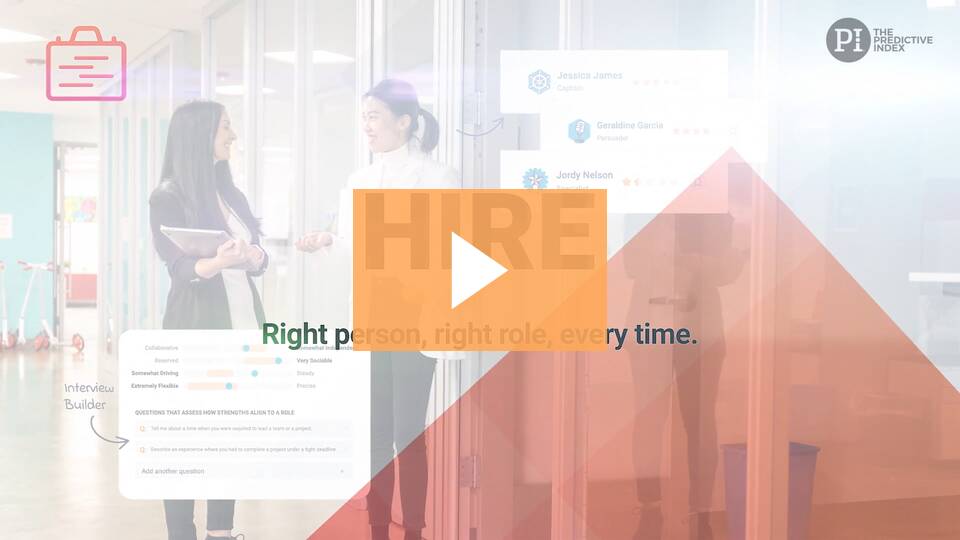Our Solutions
Recruitment

Assessments for hiring and promoting
We know that recruitment can sometimes be both difficult and frustrating.
We offer a solution that, with the help of PI's assessments, makes the process simpler, more objective, and more accurate.
The solution we work with is The Predictive Index, which is an overall solution with a common thread throughout the entire employee life cycle. The part that focuses on and helps you with recruitment is called Hire and consists of three assessments that help you recruit and promote the right person to the right role. The information you receive during recruitment can then also be used to create effective onboarding for new employees and in succession planning.
To make the most of the system, Predictio also offers you the training and support you need to find the best talent and build an engaged workforce.
Use the PI Hire solution for
Hire the right talent with PI
- The PI Job Assessment™ empowers your recruitment team to work together in identifying the behavioral traits and cognitive aptitudes that candidates require to excel in the role you are recruiting for.
- Create a captivating job ad that will attract top candidates with an optimal job fit.
- Objectively map candidates' natural drives and behaviors with the PI Behavioral Assessment™.
- Predict how quickly someone will learn the necessary skills for their new job by using the PI Cognitive Assessment™.
- Evaluate how well candidates' behavioural drives and cognitive abilities match the requirements for a specific role by using the match score function in the PI system.
- Use the match score to automatically generate objective and targeted interview questions to adress any job fit gap.
- The information collected during interviews, along with the PI Behavioral & PI Cognitive Assessment™, will help you make informed and unbiased decisions about which candidate is best suited for the role.

Recruitment
Why recruitment tests?
Recruiting the right talents is crucial for a company's success, which is why it is important to have a qualitative and well-functioning recruitment process. Recruitment tests are a useful tool that can help employers assess candidates' competencies, skills, and personality. By using these tests, the risk of hiring the wrong person can be reduced, and the chances of finding a suitable candidate who fits the company's needs and culture can be increased. Research shows that the use of personality tests and cognitive tests increases the predictability of future job performance.
Four tests for recruiting the right talent
There are many different types of tests that can be used in recruitment. Here are four of the most common ones:
1. Cognitive tests: These tests measure a candidate's general cognitive ability, which shows how they absorb new information, adapt to changes, solve problems, and process complex information. They can help assess the candidate's capacity to handle complex tasks and make quick decisions.
2. Personality tests: Candidate's personality, needs, and behavioral patterns are the focal points when it comes to personality tests. They can help the employer assess whether the candidate fits the job, the company's culture, and how they would function in the new team.
3. Job simulation tasks: This type of test provides the candidate with a task or scenario similar to the job duties in the position being applied for. They can help the employer assess the candidate's practical skills and how they would perform on the job.
4. Interviews: While interviews are not technically tests, they are still an important tool in the recruitment process. By asking relevant questions and assessing the candidate's responses, one can evaluate their experience, motivation, and suitability for the position.
By using different types of tests, a more complete picture of candidates' abilities, behavioral preferences, and personality can be obtained, which can help make more informed decisions about who should be hired. However, it is important to use the tests correctly and only as part of a broader recruitment process, as humans are complex, and there are several factors that will influence whether they are the right candidate for the position or not.
PI can be a great help when it comes to tests when recruiting, but it doesn't end there. The whole employee life cycle can be made more effective through the tools that PI provides. You can read more about how PI can be used even after a signed contract here.
Onboarding
As previously mentioned, you can also use PI's solution for onboarding. To you ensure that your new employees stay, thrive and perform in the organization.
Onboarding is a process that aims to effectively integrate new employees into the organization. It involves introducing new employees to the company's culture, values, and routines, as well as providing them with the necessary knowledge and tools to perform their job duties effectively.
A well-planned onboarding process can have several positive effects on the organization. It helps reduce turnover since new employees who feel welcomed and well-informed about their role are more likely to stay in their jobs. Additionally, the onboarding process can help increase efficiency and productivity by enabling new employees to quickly learn the necessary skills and tools to perform their job duties.
Here you can read more about the importance of an onboarding process that is shaped for every individual's own needs.

An effective onboarding process can include different steps and activities, depending on the organization's needs and culture. Here are some common steps involved:
Preparation before the new employee's first day: Before the new employee starts their job, it is important to prepare the workspace and be ready to provide necessary tools and equipment. It may also be a good idea to send information about the company's culture, values, and routines in advance.
Introduction to the company and team: The first day is crucial for giving new employees a sense of belonging and introducing them to the company. This can include a tour of the workplace, introductions to colleagues and management, and an overview of the company's operations.
Training and development: New employees need training to perform their job duties effectively. This may include training on the company's systems, procedures, and products.
Follow-up: It is important to continuously follow up, check-in, and evaluate the onboarding process during the early days to ensure its effectiveness. It is also important to ensure that new employees have access to support and assistance when needed.
An effective onboarding process can contribute to a better work environment, increased productivity, and reduced turnover. It is important for the organization to invest time and resources in a well-planned and thoughtful onboarding process to give new employees a strong start to their careers and contribute to the organization's success.
It's important to note that the same process may not suit all new employees equally well, so it is crucial to customize onboarding based on the unique individual and role. Learn more about how you can ensure onboarding that provides the best possible conditions for your new hires with the help of PI.
Succession planning
A strategy to ensure the future of the company
The solution we offer is also an excellent tool for succession planning
Succession planning is about ensuring that your company or organization continues to be successful even after key individuals have left the organization. A succession plan is necessary to ensure that critical knowledge and expertise within the organization are not lost. The plan outlines who will replace an employee who is no longer available to perform the job.
Through succession planning, you prepare your organization for unforeseen situations, making them easier to handle. The question you need to ask yourselves is simply: How do you replace employees with key skills when they are no longer there?
Here is a step-by-step guide on what you need to do:
1. Review your organization's current and future needs. Which are your business-critical roles and the competencies essential for these roles?
Our recommendation is to create a job profile using PI Job Assessment for these roles in order to determine the behaviors and cognitive abilities required for success.
Remember that these roles are not necessarily limited to leadership positions. Specialists and support functions can also be crucial for the functioning of the business.
2. Establish an open dialogue with the employees currently in these roles. Discuss their future plans and next steps. How long can you expect them to stay in their roles?
3. Next, identify potential successors for these roles. Are there any natural successors within the organization? What do these individuals need to develop and learn to be ready to take over?
If there are no natural successors currently, can you create successors by developing and training employees in more junior positions? Is there someone whose motivations and general cognitive abilities align and who could be a strong candidate?
4. Ensure that there are incentives for managers to help their team members develop and advance within the organization. It could be part of the leaders' own goals to be evaluated based on how well they assist team members in developing and acquiring new competencies, including their own replacements.
5. Strive to build a company and culture where you support each other's development and growth. This will increase the likelihood of high-performing employees wanting to stay within the company when they see internal career paths, while also securing the future of the business.
If you have a systematic approach to succession planning, you will also prepare your organization for future changes and ensure that you have the right competencies over time.
Feel free to reach out to us at info@predictio.com to discuss how you can optimize your succession planning using PI!
